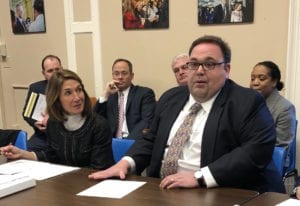Who is a member?
Our members are the local governments of Massachusetts and their elected and appointed leadership.

Lindsay DeRoche, director of the Department of Telecommunications and Cable’s Competition Division, explains 5G and “small cell” technology during the May 14 meeting of the Local Government Advisory Commission.
At the May 14 meeting of the Local Government Advisory Commission, the Massachusetts Department of Telecommunications and Cable presented an overview of local authority in relation to wireless broadband infrastructure deployment.
Lindsay DeRoche, director of the DTC’s Competition Division, explained 5G technology and how the demand for data is driving deployment and the increasing density of networks.
“Unlike previous rollouts, 5G is not a revolutionary switch,” DeRoche said. “Instead, 5G is a collection of technologies that will coexist with the 4G network and enable more efficient use of spectrum space and increase data speeds and capacity.”
He said “small cell” technology is meant to ease congestion on networks. While it is used to support 4G right now, these sites may be used to support 5G technology in the future.
Small cell equipment varies greatly in size, shape and appearance. It is typically placed 20 to 40 feet above ground level, with a range of anywhere from a few hundred feet to 1,000 feet.
“This technology is seen as a supplement to and not a replacement for macro cell networks,” DeRoche said.
A Third Report and Order from the Federal Communications Commission, effective Jan. 14, prohibits any state or local regulations that “materially inhibit” the provision of wireless telecommunication services. In response, the Department of Telecommunications and Cable is offering tips and guidelines for municipal officials.
The DTC’s recommends that local officials:
• Review municipal rules and ordinances for compliance with new standards as well as their ability to protect community interests.
• Be mindful of the process for reviewing applications and understanding how they are affected by federal timeframes.
• Keep in mind that the FCC order gives local authorities one opportunity to check applications for completeness.
• Review application forms to ensure that they require all the information necessary to make a decision. Localities may ask for detailed information about the specific installation or attachment, including schematics of equipment that is necessary to operate the wireless facility. The FCC order prohibits requiring a showing of need.
• Consider a pre-submittal conference, comprehensive provider agreements, and pre-approved design standards as tools to help deal with large requests.
The DTC also reminds local governments that moratoria or fee structures that are not cost-based do not comply with the FCC order.
Following the FCC order, the Commonwealth has revised its small cell license application, application instructions, and template small cell license for wireless deployments on state-owned assets and rights-of-ways. These documents, posted on the MMA website in the Resource Library, can serve as templates for city and town use.
The department has also offered to visit local officials in their city or town to discuss 5G and small cell issues specific to the community. For more information, contact Lindsay DeRoche at Lindsay.Deroche@mass.gov or 617-368-1112.